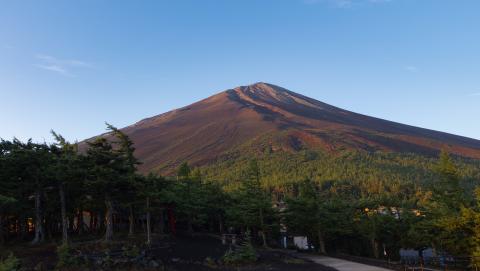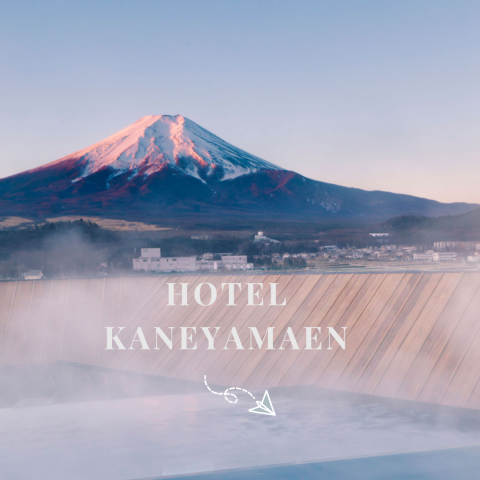Main content starts here.
I opened one of my eyes to peer over at my coworker, who was sitting beside me; he sat there quietly, with a slightly troubled expression on his face. Then, the monk pacing in front of us stopped to meet his gaze with an understanding, dutiful expression.
My coworker then clasped his hands together, and leaned in for a half-bow. Then, without a moment’s delay, the monk struck him on the back with a long, thin plank of wood.
And all I could think was, “Oh jeez, I’m next…”
But first, let’s rewind back a bit.

▲Gate of Erinji Temple (Koshu City)
On a warm autumn day, we headed to Erinji Temple in Koshu City, Yamanashi. Its large temple grounds were shrouded in nature that was tinged with autumn hues. The ginkgo trees were everywhere, and I had almost forgotten that this beautiful tree species is actually endangered.

▲Autumn-colored ginkgo tree
As we proceeded deeper into the grounds, we were met by our guide for the day, the chief temple priest, Priest Kaneko. I couldn’t tell what shocked me more, his very impressive American accent or the fact that his first name was Soy (yes, like the sauce). His welcoming demeanor along with his dad jokes made us feel right at home, and we knew this was going to be a great day.
He led us to a large tatami room in an adjacent alcove with a beautiful view of the garden. There were just enough floor pillows for our group of seven, plus Priest Kaneko.
“Recently, the concept of mindfulness has been growing in popularity, both in the US and other overseas countries. And so many foreign tourists have started coming to our temple, expecting to experience the same concept. However, Zazen is a bit different from mindfulness meditation,” he explained.
“Mindfulness is to gain something. Zazen is about letting go of something.”
He asked us to imagine a cup filled to the brim with water. Then, he had us imagine filling that same cup with even more water. What do you think would happen?
One member of our group answered, almost poetically, “It would overflow, and any further teachings or learnings would be impossible. Zen Flesh, Zen Bones. 1957. I think we read the same book.”
“Page 112?”
“113.”
We laughed.
Priest Kaneko then explained that for Zen monks, emptying one’s mind through Zazen allows for new wisdom and knowledge to enter, which is very important. He challenged us to try it out ourselves.
For our first attempt, we were instructed to correct our posture, and breathe steadily. The goal was to empty our minds completely and sit there, motionless. No useless thoughts. Or rather, no thoughts whatsoever. And through this, we would be able to attain enlightenment.
Easy, right?
Nope.

▲Zazen Meditation
We then heard two wooden planks being clanked together, followed by the clear striking of a bell, signaling the end of our first attempt. Priest Kaneko then asked us how it went.
“I couldn’t help but think about what I wanted for lunch,” said one group member.
“There was a second where I wasn’t thinking about anything. But then, I realized I was thinking about not thinking, and immediately I thought, oh crap...”
For me personally, my first and immediate thought was “I think, therefore I am.” Then, I started wondering if it was even possible to ‘not think,’ before breaking out into a song in my head to mask the silence.
Clearly, we all had quite a similar experience.
No wonder it takes so many years to truly reach enlightenment…
After reminding us not to take this unsuccessful attempt to heart, Priest Kaneko gave us some tips and tricks for our second attempt.
The key, he said, is to count your breaths.
In, “one”—out.
In, “two”—out.
In, “three”—out.
Count up to five, then start over. If you happen to mess up and catch yourself thinking, you need to start over again. Counting is a method to help one stay focused, and shut out any intruding thoughts.
For this attempt, however, instead of meditating alongside us, Priest Kaneko paced in front of us while we meditated, holding a long stick called “keisaku.” If we were to get distracted and start having thoughts, we were instructed to put our palms together and bow before him when he passed by. Upon doing so, he would return the bow, then use his keisaku to strike us on the back (in a non-painful way, of course). Then, we would be able to try again.
Let’s just say, it didn’t take long for the first member of our group to get hit.
Just when I had managed to make it to around a minute without having any intruding thoughts, I heard the sound of my coworker getting slapped on the back, which caused me to think…
“Oh jeez, I’m next…”

But by the time I half-opened an eye to see where the priest was (Zazen can be done with eyes half-open or fully closed), he was already gone, leaving me free to painlessly start my counting again.
In the end, I managed to count to 60 enough times to know that our session had lasted at least 10 minutes, and I have to admit I was quite proud of myself for being able to do so. But then, we met Zen Master, Mr. Furukawa, who proceeded to burst my bubble.
He said that every time they get people who say, “I didn’t falter, I was able to count the entire time!” they praise them for their efforts before reminding them that, “If you kept thinking about numbers, you can’t exactly say your mind was in a clear state.”
…and there went my bragging point. It’s clear that I still have a lot to learn…
The Zazen meditation experience at Erinji Temple is definitely something I would recommend trying. From the kindness of Priest Kaneko and Master Furukawa, to the opportunity of working towards inner-peace—the place just has so much to offer. Although not many know it, Erinji Temple is also actually famous for being the final resting place of the famous warlord, Takeda Shingen.
To experience it for yourself, be sure to put Koshu City on your bucket list!
More Info
Erinji Temple website:
https://erinji.jp
Getting there: By bus, from the south exit of JR Chuo Main Line, Enzan Station, take the Nishizawa-keikoku-bound bus and get off at the Erinji-mae stop.
Published on
- April 14, 2022
Share
-

Fuji Subaru Line 5th Station & Mt. Fuji Travel Guide
March 3, 2025
Home of Mt. Fuji > Staff Journal > Zazen Meditation at Erinji Temple

